
Definition of a Hartley oscillator

A Hartley Oscillator is a type of oscillator that utilizes two series-connected inductors or an inductor with a center-tapped coil, along with a capacitor. The tank circuit is created by the inductor and the parallel capacitor. An oscillator circuit necessitates an amplifier that has a feedback path between the output and input. The feedback point for the Hartley oscillator is located between the two inductors or at the tap on the inductor, as illustrated in the diagram. The amplifier employed in these circuit examples is a transistor, although any amplifier can be utilized. The definition of a Hartley oscillator specifies only the method of the feedback tap, allowing for any transistor configuration to be used. The graphic below presents three distinct Hartley oscillators, each employing a different transistor configuration: Common Base (CB), Common Emitter (CE), and Common Collector (CC). The tuned circuit, or tank circuit, remains identical across each layout. Any type of transistor may be implemented; it is important to note that the configuration graphic uses PNP transistors as examples, while the circuits utilize NPN transistors. The tuned circuit of an oscillator can be connected to the amplifier circuit in one of two manners. A series-fed oscillator utilizes a tank circuit that is in series with the same supply voltage used to power the amplifier. Conversely, a shut-fed oscillator has the tuned circuit in parallel with the amplifier's supply voltage, allowing the amplifier to draw its current directly from the supply, although there may be a bias component between the two. The frequency of oscillation is determined by the values of the inductors and capacitor used in the tank circuit. The fundamental equation for the frequency of oscillation, which includes the total inductance of both inductors (Lt), is given by: Fo = 1 / [2 x 3.1415 x (Lt x C)^(1/2)]. The total inductance is computed using the individual values of the inductors and their mutual inductance, such that Lt = L1 + L2 + M (the coupling factor). Another example of a Hartley oscillator is illustrated below. The circuit again employs a transistor, but it could easily be substituted with a FET. A PNP transistor could also be utilized if the polarity of the supply voltage is altered. The coupling capacitors are labeled in the circuit but are not related to the tuned circuit. The variable capacitor in the LC circuit is the component that forms part of the tuned circuit.
The Hartley oscillator is a widely used electronic oscillator that is particularly valued for its simplicity and effectiveness in generating sine wave signals. The design is characterized by its use of two inductors, which can either be separate components or a single inductor with a center tap. This configuration allows for flexibility in tuning the oscillator's frequency by varying the inductance or capacitance in the tank circuit.
The tank circuit, consisting of the inductors and a capacitor, is responsible for determining the oscillation frequency. The feedback mechanism is crucial for sustaining oscillations; the feedback signal is derived from the voltage across one of the inductors or the tap point, which is then fed back to the input of the amplifier. This feedback loop is essential for maintaining the oscillation, as it reinforces the input signal.
Transistor configurations in Hartley oscillators can vary, with the most common being the Common Base, Common Emitter, and Common Collector arrangements. Each configuration affects the gain, input, and output impedance of the oscillator, allowing for optimization based on the specific application. The choice of NPN or PNP transistors will depend on the required circuit design and the polarity of the power supply.
The method of connection between the tank circuit and the amplifier circuit plays a significant role in the oscillator's performance. In a series-fed configuration, the tank circuit is directly in line with the power supply, which can influence the overall efficiency and output amplitude. In contrast, the shut-fed configuration allows for greater flexibility in how the amplifier interacts with the tank circuit, potentially improving stability and performance.
To calculate the frequency of oscillation accurately, it is essential to consider both the inductance values and the mutual inductance between the coils. The formula provided allows for precise determination of the frequency based on the selected components, facilitating the design of oscillators tailored for specific frequency requirements.
Overall, the Hartley oscillator remains a fundamental building block in various electronic applications, including RF transmission, signal generation, and waveform synthesis, due to its straightforward design and reliable performance characteristics.A Hartley Oscillator is a style of oscillator that uses two series connected inductors or an inductor with a center tapped coil, along with a capacitor. The tank circuit is formed by the inductor and the parallel capacitor. An oscillator circuit requires an amplifier which has a feedback path between the output and input. The feedback point for th e Hartley oscillator is between the two inductors, or the tap on the inductor, as shown in the diagram. The amplifier used in each of these circuit examples is a transistor; although any amplifier could be used.
Because the definition of a Hartley oscillator only defines the method of the feedback tap any transistor configuration may be use. The graphic below shows three different Hartley oscillators, each using a different transistor configuration: Common Base [CB], Common Emitter [CE], and Common Collector [CC].
The tuned circuit, or tank circuit is identical in each different layout. Either type of transistor may be used; note that the configuration graphic uses PNP transistors as examples, but the circuits use NPN transistors. The tuned circuit of an oscillator may be connected to the amplifier circuit in one of two ways. A series-fed oscillator uses a tank circuit which is in series with the same supply voltage used to drive the amplifier.
A shut-fed oscillator will have the tuned circuit in parallel with the amplifiers supply voltage. So that the amplifier draws its current directly from the supply, although there might be a bias component between the two. The frequency of oscillation is determined by the inductor(s) and capacitor values used in the tank circuit.
The basic equation for the Frequency of Oscillation, which includes the total inductance of both inductors [Lt] is used: Fo = 1 / [2 x 3. 1415 x (Lt x C)1/2]. The total inductance is calculated by the individual values of the inductors and their mutual inductance; so; Lt = L1 + L2 + M (the coupling factor).
Another example of a Hartley oscillator is shown below. The circuit uses a transistor again, but that could easily be replaced by a FET. A PNP transistor could also be used if the polarity of the supply voltage was changed. The coupling capacitors are labeled in the circuit, but have nothing to do with the tuned circuit. The variable capacitor in the LC circuit is the one that forms part of the tuned circuit. 🔗 External reference
The Hartley oscillator is a widely used electronic oscillator that is particularly valued for its simplicity and effectiveness in generating sine wave signals. The design is characterized by its use of two inductors, which can either be separate components or a single inductor with a center tap. This configuration allows for flexibility in tuning the oscillator's frequency by varying the inductance or capacitance in the tank circuit.
The tank circuit, consisting of the inductors and a capacitor, is responsible for determining the oscillation frequency. The feedback mechanism is crucial for sustaining oscillations; the feedback signal is derived from the voltage across one of the inductors or the tap point, which is then fed back to the input of the amplifier. This feedback loop is essential for maintaining the oscillation, as it reinforces the input signal.
Transistor configurations in Hartley oscillators can vary, with the most common being the Common Base, Common Emitter, and Common Collector arrangements. Each configuration affects the gain, input, and output impedance of the oscillator, allowing for optimization based on the specific application. The choice of NPN or PNP transistors will depend on the required circuit design and the polarity of the power supply.
The method of connection between the tank circuit and the amplifier circuit plays a significant role in the oscillator's performance. In a series-fed configuration, the tank circuit is directly in line with the power supply, which can influence the overall efficiency and output amplitude. In contrast, the shut-fed configuration allows for greater flexibility in how the amplifier interacts with the tank circuit, potentially improving stability and performance.
To calculate the frequency of oscillation accurately, it is essential to consider both the inductance values and the mutual inductance between the coils. The formula provided allows for precise determination of the frequency based on the selected components, facilitating the design of oscillators tailored for specific frequency requirements.
Overall, the Hartley oscillator remains a fundamental building block in various electronic applications, including RF transmission, signal generation, and waveform synthesis, due to its straightforward design and reliable performance characteristics.A Hartley Oscillator is a style of oscillator that uses two series connected inductors or an inductor with a center tapped coil, along with a capacitor. The tank circuit is formed by the inductor and the parallel capacitor. An oscillator circuit requires an amplifier which has a feedback path between the output and input. The feedback point for th e Hartley oscillator is between the two inductors, or the tap on the inductor, as shown in the diagram. The amplifier used in each of these circuit examples is a transistor; although any amplifier could be used.
Because the definition of a Hartley oscillator only defines the method of the feedback tap any transistor configuration may be use. The graphic below shows three different Hartley oscillators, each using a different transistor configuration: Common Base [CB], Common Emitter [CE], and Common Collector [CC].
The tuned circuit, or tank circuit is identical in each different layout. Either type of transistor may be used; note that the configuration graphic uses PNP transistors as examples, but the circuits use NPN transistors. The tuned circuit of an oscillator may be connected to the amplifier circuit in one of two ways. A series-fed oscillator uses a tank circuit which is in series with the same supply voltage used to drive the amplifier.
A shut-fed oscillator will have the tuned circuit in parallel with the amplifiers supply voltage. So that the amplifier draws its current directly from the supply, although there might be a bias component between the two. The frequency of oscillation is determined by the inductor(s) and capacitor values used in the tank circuit.
The basic equation for the Frequency of Oscillation, which includes the total inductance of both inductors [Lt] is used: Fo = 1 / [2 x 3. 1415 x (Lt x C)1/2]. The total inductance is calculated by the individual values of the inductors and their mutual inductance; so; Lt = L1 + L2 + M (the coupling factor).
Another example of a Hartley oscillator is shown below. The circuit uses a transistor again, but that could easily be replaced by a FET. A PNP transistor could also be used if the polarity of the supply voltage was changed. The coupling capacitors are labeled in the circuit, but have nothing to do with the tuned circuit. The variable capacitor in the LC circuit is the one that forms part of the tuned circuit. 🔗 External reference





